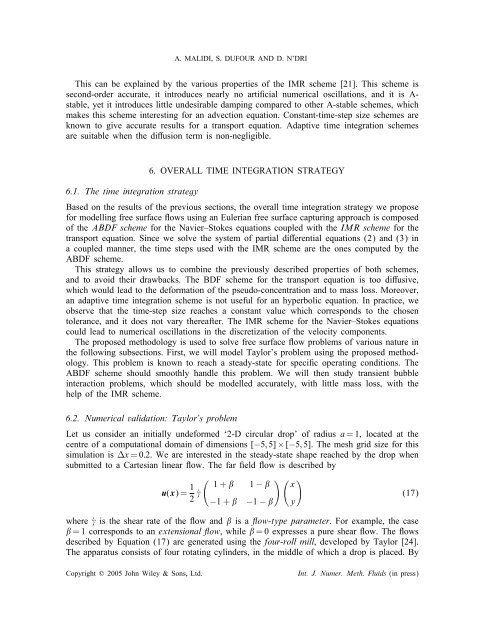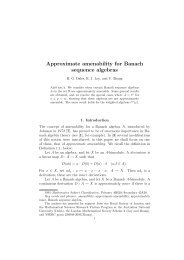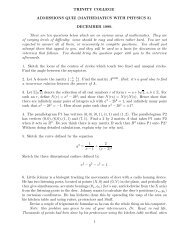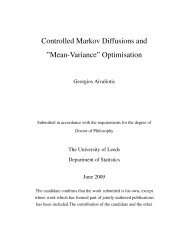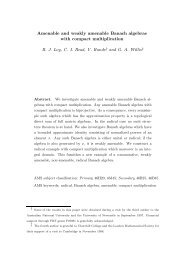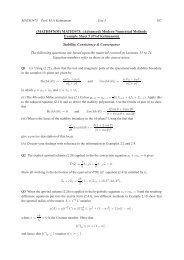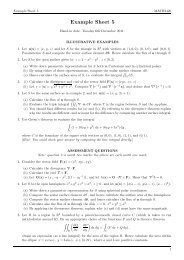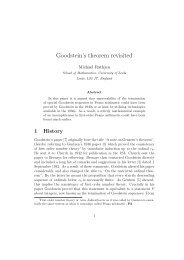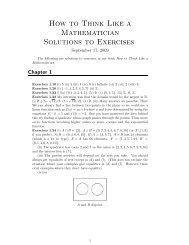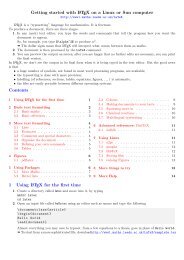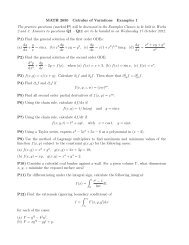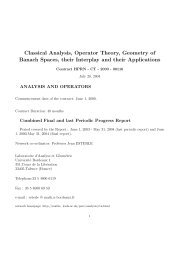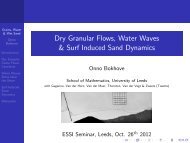A study of time integration schemes for the numerical modelling of ...
A study of time integration schemes for the numerical modelling of ...
A study of time integration schemes for the numerical modelling of ...
Create successful ePaper yourself
Turn your PDF publications into a flip-book with our unique Google optimized e-Paper software.
A. MALIDI, S. DUFOUR AND D. N’DRIThis can be explained by <strong>the</strong> various properties <strong>of</strong> <strong>the</strong> IMR scheme [21]. This scheme issecond-order accurate, it introduces nearly no articial <strong>numerical</strong> oscillations, and it is A-stable, yet it introduces little undesirable damping compared to o<strong>the</strong>r A-stable <strong>schemes</strong>, whichmakes this scheme interesting <strong>for</strong> an advection equation. Constant-<strong>time</strong>-step size <strong>schemes</strong> areknown to give accurate results <strong>for</strong> a transport equation. Adaptive <strong>time</strong> <strong>integration</strong> <strong>schemes</strong>are suitable when <strong>the</strong> diusion term is non-negligible.6. OVERALL TIME INTEGRATION STRATEGY6.1. The <strong>time</strong> <strong>integration</strong> strategyBased on <strong>the</strong> results <strong>of</strong> <strong>the</strong> previous sections, <strong>the</strong> overall <strong>time</strong> <strong>integration</strong> strategy we propose<strong>for</strong> <strong>modelling</strong> free surface ows using an Eulerian free surface capturing approach is composed<strong>of</strong> <strong>the</strong> ABDF scheme <strong>for</strong> <strong>the</strong> Navier–Stokes equations coupled with <strong>the</strong> IMR scheme <strong>for</strong> <strong>the</strong>transport equation. Since we solve <strong>the</strong> system <strong>of</strong> partial dierential equations (2) and (3) ina coupled manner, <strong>the</strong> <strong>time</strong> steps used with <strong>the</strong> IMR scheme are <strong>the</strong> ones computed by <strong>the</strong>ABDF scheme.This strategy allows us to combine <strong>the</strong> previously described properties <strong>of</strong> both <strong>schemes</strong>,and to avoid <strong>the</strong>ir drawbacks. The BDF scheme <strong>for</strong> <strong>the</strong> transport equation is too diusive,which would lead to <strong>the</strong> de<strong>for</strong>mation <strong>of</strong> <strong>the</strong> pseudo-concentration and to mass loss. Moreover,an adaptive <strong>time</strong> <strong>integration</strong> scheme is not useful <strong>for</strong> an hyperbolic equation. In practice, weobserve that <strong>the</strong> <strong>time</strong>-step size reaches a constant value which corresponds to <strong>the</strong> chosentolerance, and it does not vary <strong>the</strong>reafter. The IMR scheme <strong>for</strong> <strong>the</strong> Navier–Stokes equationscould lead to <strong>numerical</strong> oscillations in <strong>the</strong> discretization <strong>of</strong> <strong>the</strong> velocity components.The proposed methodology is used to solve free surface ow problems <strong>of</strong> various nature in<strong>the</strong> following subsections. First, we will model Taylor’s problem using <strong>the</strong> proposed methodology.This problem is known to reach a steady-state <strong>for</strong> specic operating conditions. TheABDF scheme should smoothly handle this problem. We will <strong>the</strong>n <strong>study</strong> transient bubbleinteraction problems, which should be modelled accurately, with little mass loss, with <strong>the</strong>help <strong>of</strong> <strong>the</strong> IMR scheme.6.2. Numerical validation: Taylor’s problemLet us consider an initially unde<strong>for</strong>med ‘2-D circular drop’ <strong>of</strong> radius a = 1, located at <strong>the</strong>centre <strong>of</strong> a computational domain <strong>of</strong> dimensions [−5; 5] × [−5; 5]. The mesh grid size <strong>for</strong> thissimulation is x =0:2. We are interested in <strong>the</strong> steady-state shape reached by <strong>the</strong> drop whensubmitted to a Cartesian linear ow. The far eld ow is described byu(x)= 1 ( )1+ 1 − x2 ˙ (17)−1+ −1 − )(ywhere ˙ is <strong>the</strong> shear rate <strong>of</strong> <strong>the</strong> ow and is a ow-type parameter. For example, <strong>the</strong> case = 1 corresponds to an extensional ow, while = 0 expresses a pure shear ow. The owsdescribed by Equation (17) are generated using <strong>the</strong> four-roll mill, developed by Taylor [24].The apparatus consists <strong>of</strong> four rotating cylinders, in <strong>the</strong> middle <strong>of</strong> which a drop is placed. ByCopyright ? 2005 John Wiley & Sons, Ltd.Int. J. Numer. Meth. Fluids (in press)


